
Our Lady of Fátima, is a Catholic title of the Blessed Virgin Mary based on the famed Marian apparitions reported in 1917 by three shepherd children at the Cova da Iria, in Fátima, Portugal. The three children were Lúcia dos Santos and her cousins Francisco and Jacinta Marto.
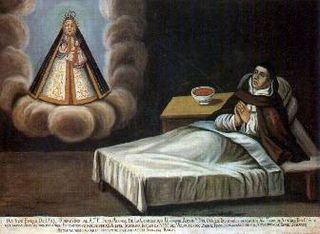
The Three Secrets of Fátima consist of a series of apocalyptic visions and prophecies which were supposedly given to three young Portuguese shepherds, Lúcia Santos and her cousins Jacinta and Francisco Marto, by a Marian apparition, starting on 13 May 1917. The three children claimed to have been visited by the Virgin Mary six times between May and October 1917. The apparition is now popularly known as Our Lady of Fátima.

Catholic Mariology refers to Mariology—the systematic study of the person of Mary, mother of Jesus, and of her place in the Economy of Salvation—within Catholic theology. Mary is seen as having a singular dignity above the saints. The Catholic Church teaches that she was conceived without original sin, therefore receiving a higher level of veneration than all other saints. Catholic Mariology thus studies not only her life but also the veneration of her in daily life, prayer, hymns, art, music, and architecture in modern and ancient Christianity throughout the ages.
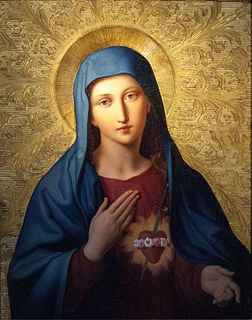
The Immaculate Heart of Mary is a devotional name used to refer to the interior life of the Blessed Virgin Mary, her joys and sorrows, her virtues and hidden perfections, and, above all, her virginal love for God the Father, her maternal love for her son Jesus, and her compassionate love for all people.

The Consecration of Russia to the Immaculate Heart of Mary by a specific act of a Pope along with all the other Catholic bishops of the world was allegedly ordered in an apparition by Our Lady of Fátima in 1917. The Carmelite nun Sister Lúcia, one of the three visionaries of the apparitions, stated that at different times the Virgin Mary had given her messages that emphasized praying the Rosary, and that she had made a number of prophecies and promises, one of these being that the consecration of Russia would usher in a period of world peace. The Vatican claimed that Sister Lúcia declared in writing during the 1980s that the consecration performed by Pope John Paul II in St. Peter's Square, in the Vatican City, on March 25, 1984 had been properly accomplished and was accepted in Heaven. The authenticity of this is not accepted, however, by experts at the Fatima Centre including Fr. Nicholas Gruner and Christopher Ferrara.
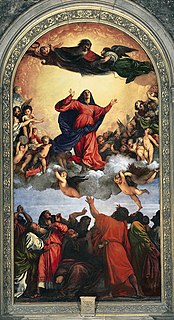
Munificentissimus Deus is the name of an apostolic constitution written by Pope Pius XII. It defines ex cathedra the dogma of the Assumption of the Blessed Virgin Mary. It was the first ex-cathedra infallible statement since the official ruling on papal infallibility was made at the First Vatican Council (1869–1870). In 1854 Pope Pius IX made an infallible statement with Ineffabilis Deus on the Immaculate Conception of the Virgin Mary, which was a basis for this dogma. The decree was promulgated on 1 November 1950.
Auspicia quaedam is an encyclical of Pope Pius XII on worldwide public prayers to the Virgin Mary for World peace and the solution of the problem of Palestine, given at Rome at St. Peter's, the first day of May of the year 1948, the tenth of his Pontificate

Deiparae Virginis Mariae is an encyclical of Pope Pius XII to all Catholic bishops on the possibility of defining the Assumption of the Blessed Virgin Mary as a dogma of faith.
Cupimus Imprimis is an apostolic letter of Pope Pius XII to all the faithful in China regarding their persecutions and the persecution of the Catholic Church.
Pope Pius XII and Russia describes relations of the Vatican with the Soviet Union, Russia, the Orthodox Church, United Oriental Churches resulting in the eradication of the Church in most parts of the Soviet Union during the Stalinist era. Most persecutions of the Church occurred during the pontificate of Pope Pius XII.

Ad Caeli Reginam is an encyclical of Pope Pius XII, given at Rome, from St. Peter's Basilica, on the feast of the Maternity of the Blessed Virgin Mary, the eleventh day of October, 1954, in the sixteenth year of his Pontificate. The encyclical is an important element of the Mariology of Pope Pius XII. It established the feast Queenship of Mary.
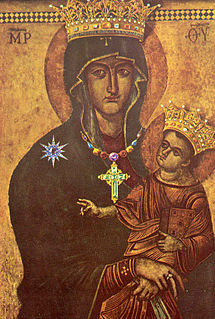
Fulgens corona is an encyclical by Pope Pius XII, given at St. Peter's, Rome, on 8 September 1953, on the Birthday of the Virgin Mary, the fifteenth year of his Pontificate. The encyclical proclaims a Marian year for 1954, to commemorate the centenary of the definition of the dogma of the Immaculate Conception of the Virgin Mary. Fulgens corona is significant as it contained the mariological methodology of Pope Pius XII and his views on limits and challenges of mariology.

The Mariology of the popes is the theological study of the influence that the popes have had on the development, formulation and transformation of the Roman Catholic Church’s doctrines and devotions relating to the Blessed Virgin Mary.

Pope Pius XII's Consecration of the world to the Immaculate Heart of Mary took place on October 31, 1942. Pope Pius XII performed a Marian consecration, entrusting the world to the Virgin Mary, as Queen of Peace, through her Immaculate Heart. This consecration was made in the context of the reported messages from Jesus and the Virgin Mary purportedly received by Blessed Alexandrina of Balazar, and communicated to her spiritual director, Father Mariano Pinho.
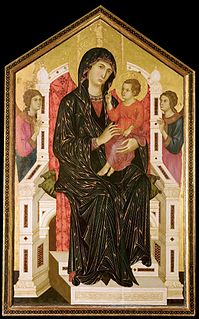
Mariological papal documents have been a major force that has shaped Roman Catholic Mariology over the centuries. Mariology is developed by theologians on the basis not only of Scripture and Tradition but also of the sensus fidei of the faithful as a whole, "from the bishops to the last of the faithful", and papal documents have recorded those developments, defining Marian dogmas, spreading doctrines and encouraging devotions within the Catholic Church.

Ubi primum is an encyclical of Pope Pius IX to the bishops of the Catholic Church asking them for opinion on the definition of a dogma on the Immaculate Conception of the Virgin Mary. It was issued on February 2, 1849

Le pèlerinage de Lourdes is the only encyclical of Pope Pius XII issued in French. It includes warnings against materialism on the centenary of the apparitions at Lourdes. It was given at Rome, from St. Peter's Basilica, on the feast of the Visitation of the Most Holy Virgin, July 2, 1957, the nineteenth year of his pontificate.
Eastern Catholic victims of Soviet persecutions include bishops and others among the tens of thousands of victims of Soviet persecutions from 1918 to approximately 1980, under the state ideology of Marxist–Leninist atheism.
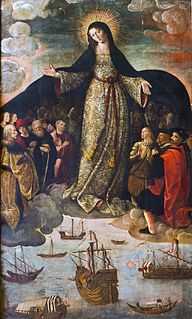
For centuries, Marian devotions among Roman Catholics have included many examples of personal or collective acts of consecration and entrustment to the Virgin Mary, with the Latin terms oblatio, servitus, commendatio and dedicatio having been used in this context. Consecration is an act by which a person is dedicated to a sacred service, or an act which separates an object, location or region from a common and profane mode to one for sacred use. The Congregation for Divine Worship and the Discipline of the Sacraments clarifies that in this context, "It should be recalled, however, that the term "consecration" is used here in a broad and non-technical sense: the expression is use of 'consecrating children to Our Lady', by which is intended placing children under her protection and asking her maternal blessing for them".
Mikhail Gavrilov, professor, religious writer, historian, teacher, Russian Catholic apostolate in exile, member of the a parishioner of the Greek Catholic Church of the Annunciation in Brussels after of Parish of Holy Trinity in Paris, author and fellow publishers of the newspapers "Life with God" and "East Christian Center" and member of Russian apostolate in the Diaspora. Gavrilov's works broadcast transmissions to the world and the light of life looked out on the waves of the Monte Carlo.













